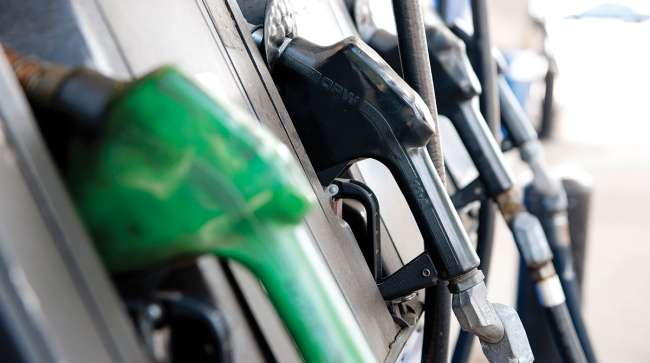Staff Reporter
Diesel Falls 7.1¢ to $5.073 a Gallon

[Stay on top of transportation news: Get TTNews in your inbox.]
The national average price of diesel shed 7.1 cents to $5.073 a gallon, according to Energy Information Administration data released April 11.
The price dropped for the second consecutive week, totaling 11.2 cents, and it marked the largest decline since it went down 11.6 cents March 21. Trucking’s main fuel now costs $1.944 a gallon more than it did at this time in 2021. Gasoline shed 7.9 cents a gallon to reach $4.091.
EIA reported that the price of diesel fell in all 10 regions it surveys. New England saw the biggest decline at 10.2 cents to $5.181 a gallon. The Rocky Mountain region experienced the smallest drop at 1.3 cents to $5.042 a gallon.
U.S. average on-highway #diesel fuel price on April 11, 2022 was $5.073/gal, DOWN 7.1¢/gallon from 4/04/22, UP $1.944/gallon from year ago https://t.co/LUjesGMQie #truckers #shippers #fuelprices pic.twitter.com/BWc7qGXsed — EIA (@EIAgov) April 12, 2022
“In my experience, we usually see prices rise and fall during the year, usually a little higher in the summer,” Tony Becnel, vice president of asset operations at Dupré Logistics, told Transport Topics. “Watching the cost rise faster than normal was alarming, as it usually takes a few weeks to move 50 cents to 60 cents historically.”
Becnel added that most years the high point of diesel prices trends close to or just above the prior year. But this year, he noted, costs set a new standard and currently average around $5 a gallon nationally. In California, the price is about $6.25.
“I’m certain at some point costs would impact the economy; I’m not sure what that cost per gallon would be,” Becnel said. “I don’t think we’ve seen it yet and may not see it this cycle. We may be having this same conversation this time next year. Prices at this level over a prolonged period of time will certainly impact the overall economy resulting in impacts to the logistics industry.”
Dupré Logistics ranks No. 90 on the Transport Topics Top 100 list of the largest for-hire carriers in North America.
“My overall thoughts or takeaway is just how much uncertainty there is out there,” Justin Frees, chief capacity officer at Arrive Logistics, told TT. “There are such elevated rates and there is so much capacity out there, more than there was a month ago. I think there is this big hold-your-breath moment going on right now.”
Frees noted the average fuel surcharge per mile increased more than 21 cents since the end of February. But at the same time, the load-to-truck ratio fell just as fast while linehaul rates came down 20 cents.
U.S. average price for regular-grade #gasoline on April 11, 2022 was $4.091/gal, DOWN 7.9¢/gallon from 4/04/22, UP $1.242/gallon from year ago https://t.co/ocHMOCTgLx #gasprices pic.twitter.com/URtMh7ht9A — EIA (@EIAgov) April 12, 2022
“In the short term, it’s encouraging that the rise has settled down,” Frees said. “It spiked up just so quickly from that last week of February to mid-March. So, it’s certainly encouraging that sharp incline has flattened off and settled down a little bit.
“But I think in the long-term view, it’s too early to tell. It’ll be interesting if it continues to settle down and stays at this mark or if it falls back down and settle somewhere in between.”
Frees noted that about a month ago his carrier partners were more interested in locking in shorter-term contracts because of the uncertainty and a decline in the spot market. They wanted 30- to 60-day contracts, sometimes 90 days. That has changed more recently.
“I think now in the last couple of weeks with some of those concerns or possibilities out there, you have a lot of carriers and a lot of brokers really obsessing over their contract and possibly trying to now lock in the more consistent contracts or long-term contracts as the spot environment continues to fall,” Frees said.
TruckLabs develops technologies for use in the trucking industry including products designed to help with fuel-cost savings. The company launched its third-generation TruckWings technology March 8. The aerodynamic device reduces drag by closing the gap between the cab and trailer.
“I think everybody is glad to see it coming down a little bit,” TruckLabs CEO Daniel Burrows told TT. “I think it’ll be high for a while. I don’t see a rapid decline in prices as far as predicting things. I think what fleets are looking at is the fact that it’s still $2 more than it was this time last year.”
He noted everybody is trying to pass the fuel surcharges on, but that still ends up being higher costs for customers. He said investing in making trucks more aerodynamic can help reduce that burden.
“I don’t see a rapid decrease in fuel prices for the rest of the year,” Burrows said. “I’m not trying to make a long-term prediction. But I don’t think we’re going to drive down to $3 a gallon for diesel in the near future.”
U.S. On-Highway Diesel Fuel Prices

Want more news? Listen to today's daily briefing below or go here for more info:

